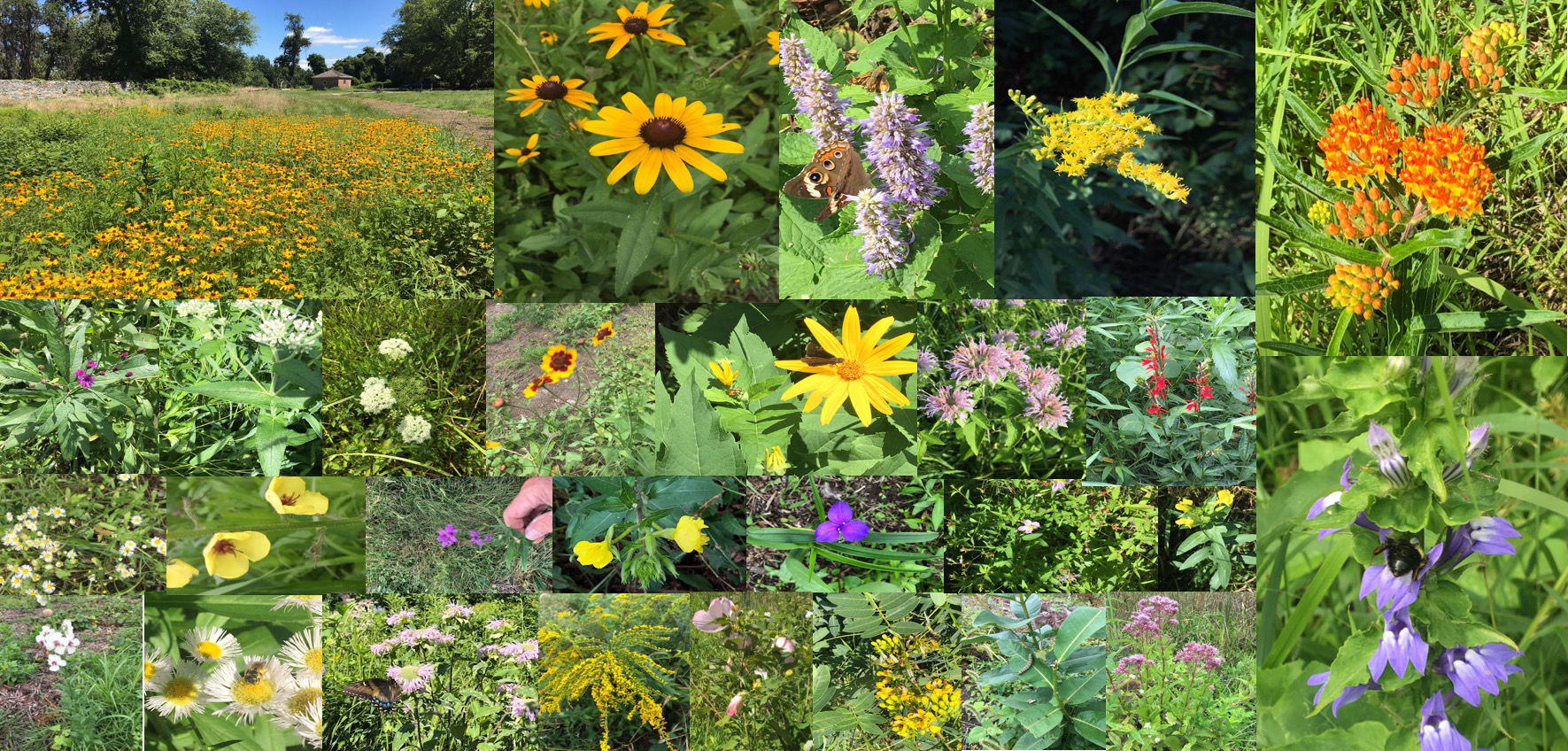Creation of the Hermitage Natural Area Meadow, a narrative.
The idea of creating trails in Trustee-owned land near the site of the Hermitage began to be implemented in March, 2016. Details are available in progress reports and excerpts of the meeting minutes of the Trustees of New Castle Common. It did not include building a wildflower pollinator meadow, but focused on creating trails to make the land accessible. The land on the four sides of the parking lot area was filled with impenetrable 6-8 ft high Japanese knotweed plants. Delaware Greenways had previously cut a trail down to a path along the marsh. But, the latter trail was impassable because of briers.Antonio Landscaping cut down the knotweed next to three sides of the parking lot with a bush hog. The parcel on the fourth side was in private hands. It would be purchased by The trustees in a few years to prevent a town house development being built adjoining the Hermitage. Equipped with loppers, a cell phone GPS and spray paint, I laid out and blazed trails as far as the railroad right of way, now the Jack Markell Trail.
Visits by experts told me what was there and what I should and shouldn't do: Kate Hackett(Delaware Wildlands), Sue Barton and Anna Wik (UD), Karen Travers (Mt. Cuba) and Tom Brightman (Longwood) said I should clear the land to make a meadow. They agreed I should leave the woods alone except to try to remove the bush honeysuckle. I should be aware of the deer browsing problem.
A soil test showed that the soil was acidic (pH 4.5-5) and fertile or excessively fertile.
The overview from the parking lot in March 2017 revealed vine covered trees and ground was covered by invasives: oriental honeysuckle bush, porcelainberry, mile-a-minute, Japanese stiltgrass, wineberry, tree of heaven, the oriental version of devil's walking stick, multiflora rose, and briers.

After clearing the first 30 feet of knotweed, a patch of marsh was visible in the distance through a gap a few feet wide at the bottom of the hill.
This reminded me of the beautiful view of the meadow garden at Longwood from near the Pierce House. Tom Brightman, who had designed the meadow, kindly visited the Hermitage and suggested a four year plan:
- Year 1: clear the land with bush hog or bobcat/forestry cutter or hydro ax, rake up the resulting mulch and treat with herbicide at least four times
- Year 2: plant with grass and wildflower seed mixes from Ernst Seed, mow several times
- Years 3 & 4: mow and start to involve volunteers who know what are the invasives for hand removal of invasives or spot spraying
Vision
Building a pollinator meadow seemed good. It seemed very good on reading Doug Tallamy's "Bringing Nature Home". It seemed very good, though daunting, on reading Travis Becks'
book "Principles of Ecological Landscape Design". He points out the desirability of biodiversity, not just many species,
but ones from different ecological niches with varying environmental needs. They are more likely to withstand variations in temperature, moisture etc.
It seemed very good, though daunting, on reading Travis Becks'
book "Principles of Ecological Landscape Design". He points out the desirability of biodiversity, not just many species,
but ones from different ecological niches with varying environmental needs. They are more likely to withstand variations in temperature, moisture etc.
What to plant.
Kate Hackett of Delaware Wild Lands suggested getting seed mixes or picking individual plants or flowers from the Ernst Seed company I did this with seeds from the 2016-17 catalog and pricelist. Desirable features: eastern U.S. native, preferably native to Delaware, add to biodiversity, moderate cost, not too aggressive, tolerates soil conditions (type, pH), sun/shade situation, moisture, salt tolerance, appropriate height, bird friendly, pollinators.
Choices and Results
I picked about 50 species of grasses and flowers from the Ernst catalog based on the above criteria and attempted to calculate the relative amount of each to order based on seeds/pound in order to achieve a meadow that had slightly more grasses than flowers (not knowing what would grow.)This table of choices and results table lists both the common and botanical names of about 50 species and their characteristics from the Ernst catalog and the 35 or so species that have grown in the meadow. Some of the others probably grew, but succumbed to deer or other animal browsing. I planted giant sunflowers in a row. The sprouted but were all snipped off. The most common animals at night are deer, fox, and raccoon.
The plants that grew are hyperlinked to their entry in the iNaturalist database along with a picture and the map location of where I saw them. Far more attractive are walking among them, and seeing the flowers themselves:
